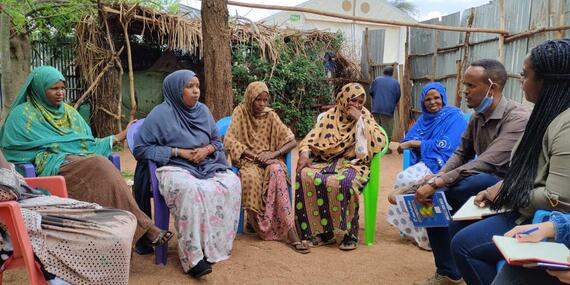Today's top news: Ethiopia, Syria, Türkiye, Madagascar

Ethiopia
Yesterday the UN with the Government and our humanitarian partners – launched an appeal for nearly $4 billion to reach more than 20 million people this year with critical assistance, including food, nutrition support, health services and other vital aid.
The southern and eastern regions continue to suffer the impact of the devastating drought, which is also affecting neighboring Kenya and Somalia. Some of these areas continue to face a cholera outbreak, with 1,100 cases recorded to date.
In recent weeks, tens of thousands of people have fled violence in Somaliland to the Somali region.
In northern Ethiopia, humanitarian access has continued to improve following the Cessation of Hostilities agreement in November last year. While a few areas remain hard to reach, the UN, NGOs, and Government have brought in more than 4,400 trucks of aid supplies into the Tigray region since mid-November. These include nearly 180,000 tons of food.
But this assistance needs to be sustained. We aim to support more than 8.5 million people are with food assistance alone across Afar, Amhara and Tigray regions.
Meanwhile, other parts of Ethiopia – particularly some areas of Oromia and neighboring Benishangul Gumuz and Amhara regions – continue to face high humanitarian needs due to violence and displacement.
Across the country, there are some 4.6 million internally displaced people who need assistance. In 2022, we and our partners reached more than 21 million people with some form of assistance. But due to access constraints and funding gaps, the level of assistance often fell short of meeting people’s needs. Last year, the humanitarian appeal, calling for $3.3 billion, was only half funded.
Syria
Today 45 truckloads of vital aid from the World Food Programme (WFP), the World Health Organization (WHO), the UN Refugee Agency (UNHCR) and the International Organization for Migration (IOM) crossed into north-west Syria. In total, 501 trucks crossed to north-west Syria since 9 February.
As of 28 February, the UN had also carried out 15 cross-border missions to north-west Syria since the first interagency visit to Idleb on 14 February. These have enabled meetings with local partners and affected communities as well as technical and needs assessments
Our humanitarian colleagues tell us they continue to scale up the response, but a lack of funding is hampering their efforts.
So far 30,000 people have received tents and 80,000 emergency non-food items. 300,000 people received ready-to-eat food rations since the beginning of the earthquake response.
There are gaps in assistance in all sectors, but especially in mental health and psychosocial support (particularly for children), food, nutrition, health, education, shelter and specialized protection services. In addition, many schools are still being used as collective shelters.
A recent assessment noted elevated levels of distress among affected people, with many exhibiting signs of post-traumatic stress disorder,
Funding is critical to our ability to scale-up to meet increased needs. As of today, the Flash Appeal for Syria is 43 per cent funded, having received US$171.2 million out of $397.6 million requested to cover three months.
Türkiye
In Türkiye, the UN and partners continue to support the Government response.
WFP has provided 5 million food packages and hot meals. Hundreds of thousands of blankets, bed sheets, tents including mattresses and tarpaulin have been provided by IOM, the UNHCR, UNICEF and International Federation of Red Cross and Red Crescent.
Other partners have also provided hundreds of thousands of hygiene, maternity and dignity kits. According to national authorities, more than 1,9 million people have evacuated from the 12 cities most affected by the earthquake and registered with the governorships and district governorships.
Madagascar
In Madagascar, we and our humanitarian partners are continuing to support Government efforts to help people impacted by Tropical Cyclone Freddy.
Cyclone Freddy made landfall on 21 February near the city of Mananjary on the east coast, which was devastated by Cyclone Batsirai last year. At least 226,000 people were affected, of whom an estimated 148,000 are in need of humanitarian assistance.
The number of people displaced by Tropical Cyclone Freddy has increased to nearly 38,000, according to the authorities, with at least seven people having died and nearly 29,000 houses being destroyed or damaged. Hundreds of schools were damaged, as well as health centers.
WFP has provided more than 53,000 hot meals in 56 shelters for people displaced by the cyclone, in addition to 20 tons of high energy biscuits. To help people recover from the disaster, WFP will provide cash-based transfers to nearly 100,000 people and food assistance to approximately 30,000 people for the next 6 months.
For its part, WHO has shipped medicine to health centres, while UNICEF has sent emergency school kits and safe drinking water to affected regions. More than 70,000 children are currently out of school.
UNICEF and the UN Population Fund are helping to provide psychosocial support for displaced families and are working on how to report and respond to any cases of sexual exploitation and abuse.
OCHA has allocated $100,000 to support the UN Humanitarian Air Service so it can facilitate assessments by air and deploy staff and supplies to the affected areas.
